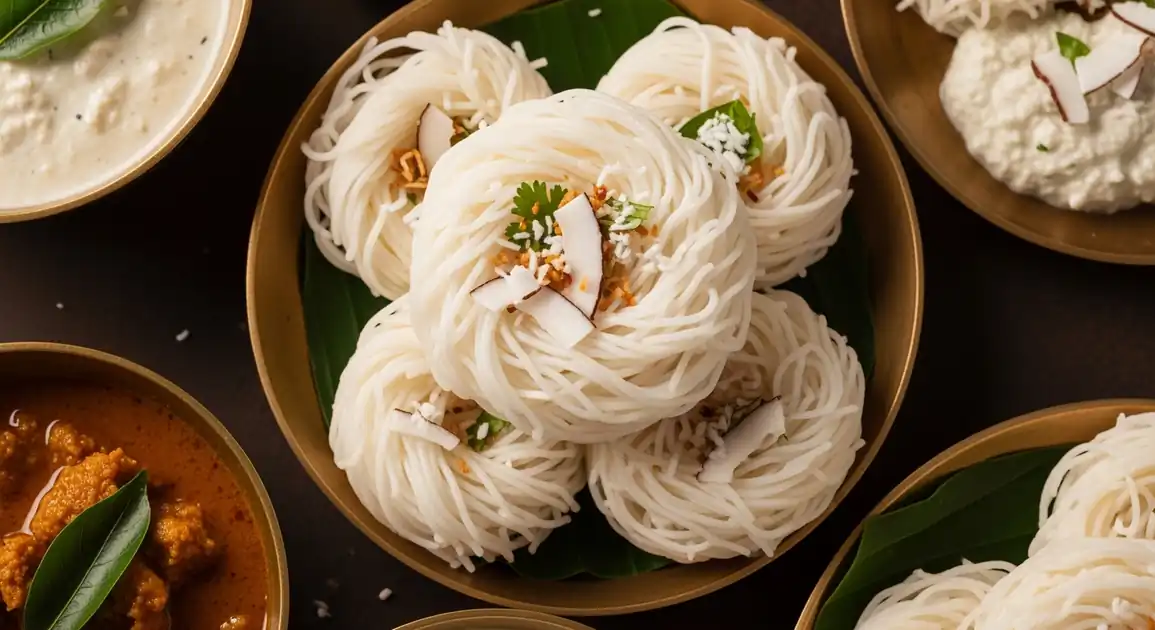Idiyappam (String Hoppers)
ඉඩියාප්පම් (Sinhala) / இடியாப்பம் (Tamil)

Description
In the historic colonial port city of Galle, idiyappam reflects both coastal Sri Lankan traditions and the international influences that have shaped this UNESCO World Heritage site. Southern coastal idiyappam typically features seafood accompaniments and distinct local spice profiles. The Dutch and Portuguese colonial history has subtly influenced local variations, creating a unique Galle twist on this traditional dish, particularly evident in the sambols and curries served alongside.
Dietary Information
Serving information
Serving style
Traditional establishments serve on banana leaves; colonial-influenced restaurants inside Galle Fort often use ceramic plates with artistic presentation. Coastal style typically includes seafood curries and coconut sambol.
Quick facts
Local restaurants: 6 AM - 10 AM. Fort area establishments: 7 AM - 10 PM. Guest houses: 7 AM - 10 AM for breakfast.
Safety Tips
What to Look For
-
Freshly steamed idiyappam with visible steam
Freshly steamed string hoppers minimize food safety concerns and offer the best texture. Look for places where you can see them being prepared or where steam is still visible from recently made batches.
-
Clean, dedicated idiyappam-making area
Establishments with a specific, clean preparation area for idiyappam typically take more care with the process and ingredients.
-
Properly stored accompaniments (curries, sambols)
While idiyappam itself is low-risk, accompaniments like curries need to be kept at safe temperatures. Avoid places where curries sit at room temperature for extended periods.
-
White or slightly off-white color with distinct strands
Quality idiyappam should be clean-looking with visible separate strands, indicating proper preparation and freshness.
-
Venues with high turnover of customers
Busy establishments typically prepare food more frequently, ensuring freshness.
What to avoid
-
Grayish, discolored, or yellowed idiyappam
Discoloration suggests old rice flour, poor storage, or idiyappam that was made long ago and has been sitting out.
-
Clumpy, mushy texture without distinct strands
Indicates either poor preparation or idiyappam that has been sitting too long and absorbed moisture from the air.
-
Sour or musty smell
Fresh idiyappam should have a neutral or slightly sweet rice aroma. Any sour smell suggests fermentation has begun, especially in tropical climates.
-
Pre-made idiyappam sitting uncovered for long periods
Exposed idiyappam can collect dust and contaminants. Prefer places that make them fresh or keep them covered.
-
Lukewarm curries that should be hot
Accompaniments like curry should be kept hot to prevent bacterial growth. Cold sambols (like pol sambol) should look fresh and vibrant.
Price information
Price range
Budget tips
- Local eateries outside Galle Fort offer economical traditional versions (100-200 LKR).
- Mid-range restaurants within the Fort area charge 250-400 LKR, targeting both locals and tourists.
- Upscale boutique hotels and specialty restaurants, especially inside the Fort, charge 400-600 LKR for premium presentations.
- Early morning options from local vendors around the Fish Market area provide good value.
- Some guest houses offer reasonably priced authentic breakfasts including idiyappam.
Value indicators
- Accompaniment with fresh seafood curries indicates local specialization.
- Proper texture: light and fluffy with distinct strands.
- Hand-pressed rather than machine-made strands.
- Generous portion of coconut sambol made with fresh, not dried, coconut.
- Inclusion of unique Southern-style curries with local spice blends.
Where to Find This Dish
Galle Fort
Mix of traditional and upscale establishments serving both authentic and fusion varieties to tourists and locals.
Inside the historic fort walls, Lighthouse area, Church Street
Morning, Noon
Galle Town (outside Fort)
More authentic, local establishments catering primarily to Sri Lankans.
Near the main market, Bus station area, Hospital Road
Early Morning, Morning
Unawatuna Beach Area
Beachside restaurants and guest houses offering breakfast with coastal variations.
Unawatuna Beach, Jungle Beach approach
Morning
Vendor Tips
- Establishments run by local families often offer the most authentic Southern-style idiyappam.
- Seafood curries accompanying idiyappam should smell fresh with no fishy odor.
- Some places inside the Fort have fusion versions that incorporate colonial influences.
How to Order
Regional Variations
-
Galle Fort Colonial
(Balakotuwa Idiyappam)
Fusion variations found inside Galle Fort that incorporate subtle Dutch or Portuguese influences in the accompaniments.
-
Southern Seafood Style
(Muhuda Idiyappam)
Served with distinctive southern coastal fish or prawn curry, often using local spice blends specific to the southern province.
-
Unawatuna Beach Breakfast
(Vella Idiyappam)
Beach area variation often including tropical fruits alongside traditional accompaniments, catering to both locals and tourists.
Cultural context
History
Idiyappam's origins trace back several centuries in South Asian culinary history, with strong connections to both Tamil and Sinhalese cuisines. The dish demonstrates the historical rice cultivation importance in Sri Lanka and the ingenious ways rice was transformed into varied textures and forms. While similar to South Indian idiyappam, Sri Lankan versions typically use distinctive accompaniments like kiri hodi (coconut milk curry) and pol sambol that reflect the island's unique culinary heritage. The preparation method using special idiyappam presses has remained largely unchanged for generations.
Local significance
In Galle, idiyappam represents the blending of inland Sri Lankan traditions with coastal influences and colonial heritage, making it emblematic of the region's diverse cultural history.
Eating customs
- Coastal areas emphasize the combination of seafood curries with idiyappam.
- Within Galle Fort, some establishments serve idiyappam with European-influenced presentation.
- Local southern spice blends make the accompaniments distinctly regional.